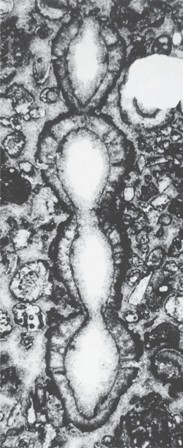Decastronema barattoloi (DE CASTRO), characteristic fossil of the Palaeocene and the Eocene peritidal sediments from the Adriatic carbonate platform
Main Article Content
Abstract
The renewed deposition in the Palaeogene and the oldest part of the non-interrupted Palaeocene succession is characterized by the presence of Decastronema barattoloi (DE CASTRO), cyanobacterial tubes originally described in the Apennines. The reinterpretation of limestones from several sections located in the Kras region (NW part of the AdCP: Basovizza, Dolenja vas, Sopada, ?ebulovica) confi rmed the presence of these microfossils in peritidal sediments of Danian age (SBZ 1). The Cuisian (Late Lower Eocene) sediments, from eastern Istria (Brnjci section), Cres Island (Koroma?na Cove section) and Ravni kotari (Benkovac–Korlat section) contain individuals of this species in great numbers. The cyanobacterial tubes are scattered in laminated, fi ne grained mudstones and wackestones, immediately above the Cretaceous sediments (occasionally above bauxites or breccias). The Decastronema-bearing sediments pass upward into the Foraminiferal limestones of Cuisian age (SBZ 11, based on conical agglutinated foraminifera and alveolinids), allowing the age determination of the cyanobacterial remnants. The Palaeocene specimens are minute (up to about 180 ?m long), thick walled tubes that occur with the index fossil Bangiana hanseni DROBNE. The Eocene forms accompanied by ostracods, pelecypods, and miliolid and rotaliid foraminifera are segmented tubes, up to 400 mm long and usually thin walled.
Downloads
Download data is not yet available.
Article Details
Issue
Section
Original Scientific Papers
Authors have copyright and publishing rights on all published manuscripts.

